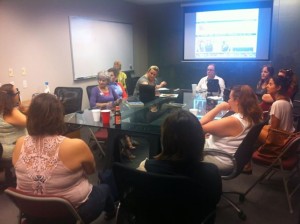Awkward, Cumbersome, Inclusive and Sensitive?
Katrina Spencer, University of Illinois, Urbana-Champaign
Many Romance languages, like Portuguese and Spanish (and French to a slightly lesser degree) have a grammatically ingrained predilection for sexism. As you’ll remember from your high school “SPAN 1AB” or college “SPAN 101” course, whenever there is a group of people and any one of them is male, they are referred to with “los,” the Spanish language definite article, as in: Los chicos, María, Juan e Isabel visitan la playa todos los veranos.
This default mode for masculine markers also shows up in what we call “demonstratives” in the world of language: Otros, por ejemplo Fernanda, Marcos, Luis y Estrella, prefieren ir a las montañas.
As you can see in the two examples above, female figures either (1) represent the majority of characters in the statement or (2) represent exactly half of the group, but the masculine article is still used.
This is an interesting and problematic space to explore for me as someone who is working as a translator for this feminist collective. On the one hand, I’ve been taught for years that respecting the conventions of formal language use is a vehicle of strong communication. This applies in arenas such as the use of the subjunctive, indirect object pronouns and precise vocabulary. On the other hand, as a 21st century learner, employee, woman and feminist by essence and association, I realize how exclusive these conventions can be when it comes to conversations about the sexes. The “o” in “los” excludes, ignores or overshadows the females it represents. What do we do?
Hi, my name is Katrina Spencer and I have used sexist language.
In this area of the FemTechCommons, periodical press releases can be found regarding the goings-on in our community. As a “grad hourly” at the University of Illinois Urbana-Champaign’s Graduate School of Information Science, one of my jobs is to translate these press releases from English to Spanish in order to include wider and even international audiences. The sexist language constraints I’ve described, however, are ones I encounter, consciously or subconsciously, every time I open my mouth to speak Spanish.
It is my belief that a good deal of the pedagogical resources shared in this space are intended for women and used by women. As a matter of fact, for every ten females I see using this space, I have seen only one male. But when I translate a document about FemTechNet users, my inclination is to type, “los estudiantes” and “los instructores.” Grammatically speaking, I’m “right” but socially I am diminishing the strong, ubiquitous and pulsing female energy that has created and developed FemTechNet.
Is there an easy solution?
María González Aguado, another FemTechNet-er like myself, brought this to my attention, although it wasn’t the first time the issue had been raised. In her words, “Feminist scholars and women’s associations consider that plural in masculine invisibilizes women, so we try to use non-sexist language using an x or @ to avoid linguistic sexism.” So, per her suggestion, the statements above would appear as Lxs chicxs, María, Juan e Isabel, visitan la playa todos los veranos. OR L@s chic@s, María, Juan e Isabel visitan la playa todos los veranos. The other sentence would be: Otrxs, por ejemplo Fernanda, Marcos, Luis y Estrella, prefieren ir a las montañas. OR Otr@s, por ejemplo Fernanda, Marcos, Luis y Estrella, prefieren ir a las montañas.
Yes, okay, that’s fine, but how, now, do I pronounce it/ say it out loud/ read it aloud?
Also, what happens when I want to say “The participants in the Video Dialogues will include Judy Wacjman, Anne Balsamo, Julie Levin Russo, Faith Wilding and many others”?
Indulge me for a moment. The only participants listed are female. “Many others” does not identify sex. Should the sentence start off as “Lxs” or “L@s” in order to leave the possibility open of men participating in the future? Or should it be “Las” because up until this point, only women have shared the space?
And given that “lxs” and “l@s” cannot be pronounced, should every sentence sound like, Los miembros y las miembras publican sus opiniones en los foros?
Is it acceptable for language to be awkward and cumbersome in order to also be inclusive and sensitive? What does “fair” and “feminist” language representation look like? Do you type/write “s/he” when referencing a figurative, anonymous and sexless third person?
Join the discussion!






